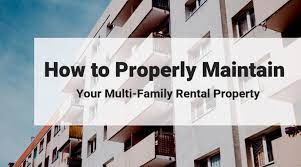How to Properly Maintain Your Rental Property?
One of the biggest landlord responsibilities facing any property owner is rental maintenance. In fact, in a national survey conducted by Smart Move, rental maintenance was ranked as the third biggest “pain point” for landlords after loss in rental income and uncooperative tenants.
That’s not surprising. Rental property maintenance requires year-round vigilance, representing a significant amount of time and money. However, landlords can avoid the “pain points” if they follow some simple rules, stay organized and budget accordingly. Below we talk about some of the strategies for managing rental maintenance.
REGULAR MAINTENANCE
Some rental maintenance issues, such as a leaky faucet, often can’t be anticipated or avoided. Other issues can be addressed before they become serious problems by following a regular maintenance schedule. These are the items that should be checked on a regular basis, whether weekly, monthly or annually, such as a yearly furnace inspection. Regular maintenance isn’t just about avoiding costly repairs but ensuring a pleasant living environment for tenants.
 The rental property maintenance checklist below is not meant to be exhaustive. Each landlord will need to tailor a regular rental maintenance schedule based on his or her property. Here are some examples of items that many good landlords do regularly.
The rental property maintenance checklist below is not meant to be exhaustive. Each landlord will need to tailor a regular rental maintenance schedule based on his or her property. Here are some examples of items that many good landlords do regularly.
- Check for leaks, especially following strong rainstorms or after significant snowmelt. Water damage is the enemy of every landlord.
- Replace air filters frequently.
- Test smoke and carbon monoxide detectors regularly.
- Check for pests quarterly if not monthly.
- Re-caulk showers and bathtubs to prevent mold and leaks.
- Tighten any handles, knobs, locks, faucets, etc.
- Check fire extinguishers.
- Flush water heater.
- Clean gutters.
- Trim or remove trees on the property threatening power lines or structures.
Landlords should also create rental maintenance schedules for bigger ticket projects, or capital expenditures, such as replacing carpets or repainting walls. The schedule will depend on the general wear-and-tear on each individual unit, but professional property managers recommend doing these sorts of projects (i.e., interior painting, carpet replacement) about every three years unless needed sooner.
REGULAR INSPECTIONS
One of the keys to maintaining your unit is to conduct rental property inspections on a regular basis. There are four types of inspections landlords can do to help ensure their properties stay in tiptop shape.
- Move-in Inspection:This walk-through inspection is typically done with the tenant. This provides an opportunity for the tenant to identify any concerns and for the landlord to document the condition of the property when it was turned over.
- Routine Inspection:Landlords should schedule regular inspections of the property with the tenant, ideally on a quarterly basis. A landlord should provide prior notification before entering the property; often the terms of the lease will specify the particulars regarding these visits, or local law will. This is an opportunity for the landlord to identify maintenance issues or for the tenant to discuss any problems such as that leaky faucet.
- Drive-by Inspection:Routinely stopping by the unit to observe its outside condition can help spot issues such as the unauthorized presence of a pet.
- Move-out Inspection: As the name implies, this inspection comes when the tenant moves out. This inspection is not only the time to identify any damage a tenant may have caused but for the landlord to note what normal wear-and-tear repairs or maintenance issues may need to be addressed before the unit is rented out again.
There are plenty of options out there for landlords who need maintenance help. Websites like Thumbtack match professionals to those in need of services such as carpet installation and interior painting. Other companies like The Luxia. Each service call is then charged a flat fee, with a guarantee to either repair or replace the item under warranty.
Leave a Reply